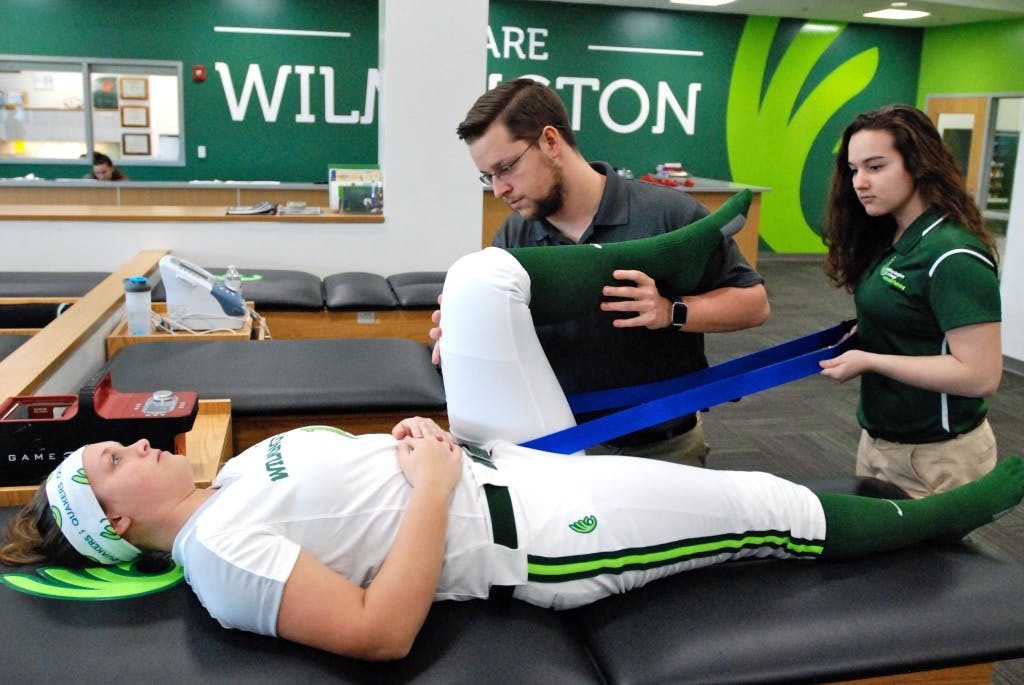Approval Process Is Well Underway for Master of Science in Athletic Training
Wilmington College’s reputation as a premiere program in athletic training dovetails well with major changes coming to higher education.
PICTURED: Robert Oates, a member of the College's certified athletic training staff and a graduate of its program, checks on a softball player's injury as an athletic training student observes.
Starting in 2022, bachelor’s degree programs in athletic training will become obsolete at accredited schools across the country. AT is becoming a graduate-level course of study and — if positive approvals continue for WC as expected — the College will implement a Master of Science in Athletic Training degree program starting in fall 2019.
WC’s undergraduate students will enroll as exercise science majors in the allied health concentration and, after three years plus one summer of studies, graduate into the master’s degree program for an additional two years. The earliest they can sit for the Board of Certification exam is late in their master’s program.
The Commission on Accreditation for Athletic Training Education (CAATE), in partnership with the National Athletic Trainers’ Assn. and the Board of Certification, is behind this major change in AT education.
Dr. Erika Goodwin, vice president for academic affairs and professor of athletic training, cited “increasing complexity in the field” as CAATE’s rationale for the new standards. “Athletic trainers are health care professionals and (requiring) graduate studies highlights the level of knowledge athletic training requires.”
She added that WC is well positioned to meet the challenges presented by this mandatory transition.
“Wilmington College has a long history of producing quality athletic trainers,” said Goodwin, who after 10 years in WC’s Academic Affairs area is returning to teaching this fall. “We have a large, well known and recognized program, both in Ohio and regionally.
“Athletic training is a prominent program at the College and I’m glad to see it continue to grow,” she added.
The new regulations are causing a number of colleges and universities to drop their comparatively small athletic training programs, another factor that could favor a well-positioned school like WC, which, in recent years, has hosted one of the larger programs in Ohio.
The College is well along in the approval process.
Goodwin said the Ohio Dept. of Higher Education (ODHE) approved the College’s proposal for the master’s program earlier this year, while WC gained the Higher Learning Commission (HLC) site visit team’s endorsement in mid-June. Once the HLC’s Institutional Actions Committee gives its final approval that clears the way for the College to submit its proposal to CAATE.
Goodwin said both the HLC, which made a site visit in May, and ODHE were especially impressed with the Athletic Training Clinic located in the Center for Sport Sciences (CSS), which opened in summer 2015. Indeed, recently officials from a professional sports team visited the facility before determining to include a smaller replica of WC’s clinic in its plans for a new training facility.
“The AT Clinic enhances the hands-on learning experience in a hands-on learning profession,” she said, adding that the four professional clinics housed in the CSS — Beacon Orthopaedics and Sports Medicine, Chiropractic Care of Cincinnati, Clinton Memorial Hospital’s Imaging and Sports Medicine Center, and Drayer Physical Therapy Institute — offer “premiere” facilities for AT students’ clinical rotations.

Graduate Program in Athletic Training on the Near Horizon
Athletic Training